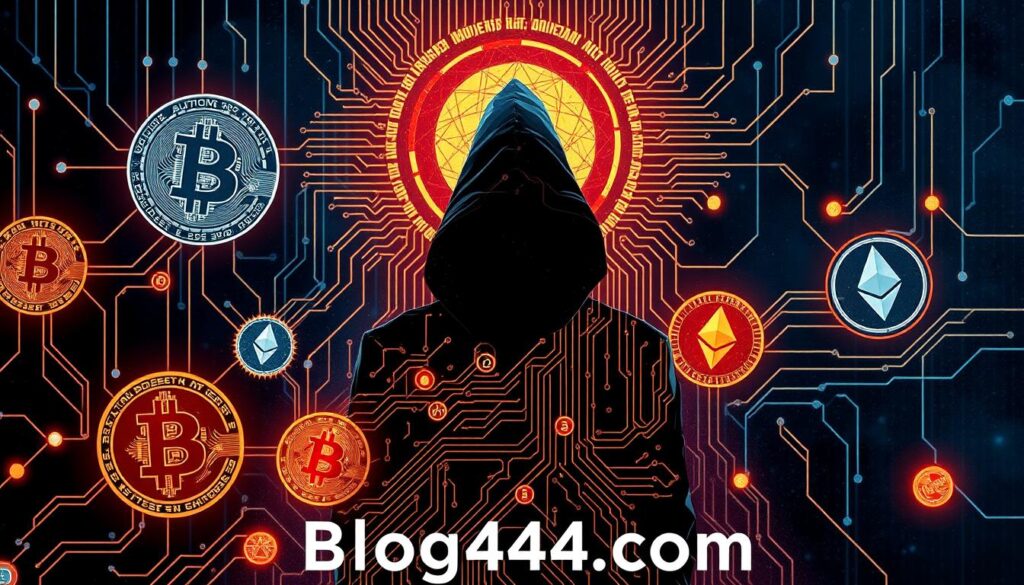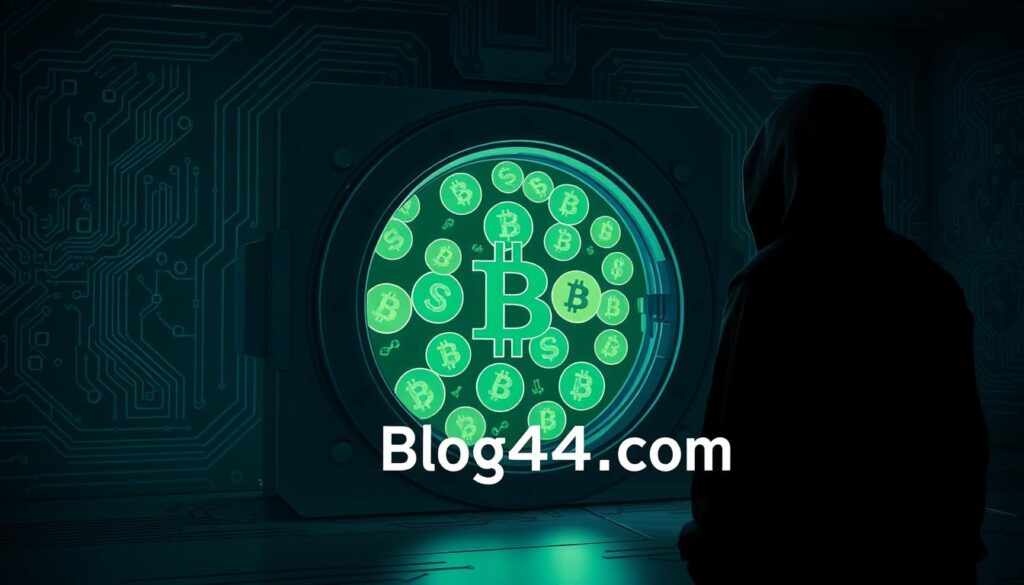Ever wondered how to send digital assets privately and securely? In today’s world, keeping your digital transactions private is more important than ever. Let’s explore how to make anonymous digital asset transfers in the world of decentralized finance.
Key Takeaways
- Anonymous digital asset transfers offer enhanced privacy and security for your financial transactions.
- Blockchain technology and privacy coins like Monero, Zcash, and Dash provide the foundation for these anonymous transfers.
- Anonymity features such as IP masking, address generation, and multi-level encryption ensure your transactions remain private.
- Understanding the legal and regulatory considerations is key when using anonymous transfer methods.
- Using secure wallets, reliable VPNs, and following best practices can further strengthen your anonymity.
In the world of1 cryptocurrencies and digital finance, making anonymous transfers is very valuable1. BitHide uses advanced 512-bit encryption to keep your data and assets safe1. It also changes your IP address many times before syncing with the network1.
BitHide automatically creates unique addresses for each transaction, spreading your financial activities across many addresses1. It also has built-in Anti-Money Laundering (AML) checks to assess the risk of incoming assets1. This keeps your transactions secure and private, even with more rules and regulations.
But anonymous digital asset transfers are not just for personal use. Businesses can also use these technologies for secure and private mass payouts1. They can upload a file of recipient addresses and amounts directly into the platform1. This way, companies can protect their financial activities and keep their operations confidential.
Yet, the world of anonymous digital asset transfers has its challenges2. Scams and fraudulent platforms are common, with people losing a lot of money to false promises2. It’s important to know the legal and regulatory landscape and the risks of anonymous transfers to stay safe and responsible.
In the next sections, we’ll dive deeper into anonymous digital asset transfers. We’ll look at the technologies behind them, why privacy is important in today’s digital world, and how to do secure and compliant transactions. By the end of this guide, you’ll know how to use anonymous transfers safely and legally.
What Are Anonymous Digital Asset Transfers?
In today’s digital world, anonymous digital asset transfers are key. They are financial deals done without sharing who’s involved. They use blockchain and cryptocurrencies for safe, private value exchanges. Peer-to-peer transactions, untraceable payments, and fungibility are central to these transfers3.
Definition and Concept
These transfers use secret codes to hide who’s involved while keeping the deal safe. This lets people and companies do private money moves. It keeps personal info safe and makes transactions secure3.
Importance in Today’s Digital Economy
Anonymous digital asset transfers are vital today. They help keep financial info safe, make business deals private, and help people in places with limited access to finance. As our digital world grows, so does the need for safe, private, and untraceable payments4.
Technologies like blockchain and DeFi are making these transfers more important and useful3.
“The ability to conduct anonymous digital asset transfers is key. It protects personal financial info, makes business deals private, and helps people in restricted areas.”
How Anonymous Digital Asset Transfers Work
Anonymous digital asset transfers use advanced technologies. The blockchain records each transaction without linking to personal identities5. To add more privacy, ring signatures (Monero) and zk-SNARKs (Zcash) hide transaction details5.
Stealth addresses are another key tool. They are made for each transaction, making it hard to trace assets back to the sender or receiver5. This mix of blockchain and privacy tools makes it tough to link transactions to people.
Underlying Technologies
The blockchain is the base for anonymous transfers. But, to keep things private, special cryptocurrencies and protocols use advanced cryptography:
- Ring Signatures: Monero uses this to hide who sent a transaction by mixing signatures5.
- zk-SNARKs: Zcash uses zero-knowledge proofs to check transactions without showing who sent or received them5.
- Stealth Addresses: These unique addresses for each transaction hide who sent and received5.
Privacy Features of Digital Asset Transfers
Blockchain and privacy tools make a strong system for private transfers. Users can use privacy-focused platforms to send money without being seen or known.
| Privacy Feature | Description |
|---|---|
| Blockchain Foundation | The blockchain records transactions without linking them to personal identities5. |
| Ring Signatures | This technique hides the sender’s identity by mixing signatures5. |
| zk-SNARKs | This zero-knowledge proof system verifies transactions without showing who sent or received them5. |
| Stealth Addresses | Unique addresses for each transaction hide who sent and received5. |

“The combination of blockchain technology and advanced anonymity-enhancing features creates a robust system for executing private digital asset transfers.”
These technologies let users send digital assets privately and securely5.
Advantages of Using Anonymous Digital Asset Transfers
Anonymous digital asset transfers have many benefits. They are great for those who want financial privacy, secure transactions, and identity protection6.
Enhanced Privacy and Security
One big plus is the extra privacy they offer. Users can keep their financial activities secret. This helps avoid identity theft or being financially profiled5.
These transfers also use strong cryptography. This makes them hard to hack or access without permission5.
Reduced Risk of Fraud
Another big plus is the lower risk of fraud. By hiding personal and financial info, users lower the risk of hackers getting their data. This is super helpful for keeping your digital life safe5.
| Feature | Benefit |
|---|---|
| Confidential Financial Activities | Protection from identity theft and financial profiling |
| Cryptographic Security Techniques | Resistance to hacking and unauthorized access |
| Obscured Personal and Financial Information | Reduced risk of fraud and data breaches |
These benefits make anonymous digital asset transfers very useful. They are perfect for keeping your finances and identity safe online65.
“The ability to transact anonymously and maintain financial privacy is becoming increasingly important in our digital world.”
Common Misconceptions About Anonymous Transfers
Cryptocurrency rules, legal needs, and keeping things transparent are key when dealing with secret digital asset moves. But, there are many wrong ideas about this topic that need to be cleared up7.
Myths vs. Reality
Many think secret digital asset moves can’t be tracked at all. But, most are actually not fully secret. They can be found with special tools7. Another wrong idea is that all secret moves are against the law, which isn’t true in many places7.
Clarifying the Legal Situation
The laws about secret digital asset moves change from country to country. Some places like the idea of keeping things private, while others have stricter rules7. It’s important to know that keeping things secret in money moves isn’t always wrong. But, it might be watched closely to stop bad things78.
In Thailand, for example, digital asset places did over 100 billion baht in trades in 2023. And, they could track all moves 100% of the time8. The Thai Anti-Money Laundering Office also found and checked 95% of suspicious crypto moves in 20238.
Worldwide, a 2024 report by Chainalysis said only 0.24% of crypto moves were bad8. Also, a 2024 report by the World Economic Forum said blockchain tech will get much better at finding bad moves by 20268.
By knowing the real deal about laws and secret digital moves, you can make smart choices. And make sure your crypto actions follow the rules78.

Popular Platforms for Anonymous Transfers
Several platforms are now known for helping with anonymous digital asset transfers. They offer different features to help users keep their transactions private and secure.
Overview of Leading Services
Decentralized exchanges like Uniswap9 and PancakeSwap are popular for anonymous trading. They let users swap tokens without needing to share personal info9. Privacy-focused wallets, such as Wasabi, also have coin mixing to hide where money comes from9.
For those looking for coin mixing services, Blender and MixTum offer tools to hide digital asset movements9. Non-KYC exchanges like KuCoin and MEXC also let users trade without sharing their identity, for certain limits9.
Bitcoin ATMs in some places let users buy small amounts of crypto without revealing their identity9.
Features Comparison
| Platform | Key Features | Anonymity Level | Supported Coins |
|---|---|---|---|
| Uniswap | Decentralized exchange, no KYC | High | Ethereum-based tokens |
| Wasabi Wallet | Privacy-focused wallet with coin mixing | Very high | Bitcoin, Litecoin, Ethereum |
| Blender.io | Specialized coin mixing service | Extremely high | Bitcoin, Ethereum, Litecoin |
| KuCoin | Non-KYC centralized exchange | Moderate | Wide range of cryptocurrencies |
| Bitcoin ATM | Anonymous cash-to-crypto purchases | High | Bitcoin |
These platforms offer different features and levels of anonymity. They meet the needs of users who want private digital asset transfers9.
“In an era where digital privacy is increasingly under threat, the rise of anonymous digital asset transfers has become a critical tool for individuals and businesses to protect their financial transactions.”
As the digital economy grows, so will the need for secure and private financial solutions. These platforms will play a key role in the financial world10119.
How to Execute an Anonymous Digital Asset Transfer
To transfer digital assets anonymously, start by using a reliable VPN12. This hides your IP address and location. It keeps your online activities private12.
Next, pick a wallet that doesn’t ask for personal info. Stay away from exchanges that need KYC info, as they can reveal your identity12. Instead, buy cryptocurrencies on peer-to-peer platforms like LocalBitcoins or Paxful. You can use cash or prepaid cards for anonymous purchases12.
For transferring assets, use a decentralized exchange (DEX) like Bisq. It allows trading without KYC12. Or, use coins like Monero, Zcash, or Dash. They hide transaction details, making them hard to trace12.
Don’t make big transactions that might get reported. Be careful when meeting for trades in person13. Use secure ways to talk and share info13.
Keeping your identity hidden in digital transfers is tricky. Follow these tips to protect your privacy1213.

What to Avoid
- Linking personal information to your transactions12
- Using centralized exchanges that require KYC12
- Making large transactions that might trigger reporting requirements13
| Key Considerations | Recommendations |
|---|---|
| Wallet Choice | Use a privacy-focused wallet without personal information requirements12 |
| Acquisition Method | Obtain cryptocurrencies through peer-to-peer trading, avoiding centralized exchanges12 |
| Transfer Mechanism | Utilize decentralized exchanges or privacy-enhancing coins12 |
| Transaction Size | Avoid large transactions that may trigger reporting obligations13 |
By following these steps and avoiding common mistakes, you can make an anonymous digital asset transfer. This way, you keep your financial privacy safe121314.
Legal and Regulatory Considerations
The world of digital assets is growing fast, but it’s full of legal hurdles. Many places have rules against money laundering and know your customer policies for digital assets15. It’s vital to follow these laws, as companies and institutions face many legal challenges15.
When money goes missing in digital assets, finding it is a big part of solving the problem15. This means looking at transactions, checking wallets, and even social media15. Experts also look at smart contracts to find security issues15.
In some places, you can’t even send money anonymously anymore. It’s important to keep up with new laws and get legal advice15. While being anonymous isn’t illegal, it can make you a target for regulators15.
| Compliance Requirement | Description |
|---|---|
| AML Regulations | Rules designed to prevent the use of financial systems for money laundering and terrorist financing activities. |
| KYC Policies | Processes that verify the identity of customers to assess the risks and comply with regulations. |
| Financial Reporting | Obligations to provide accurate and timely financial information to authorities and the public. |
Understanding the laws around digital assets is key15. Legal teams need to be ready for more complex cases as rules keep changing15.
“Compliance with AML regulations, KYC policies, and financial reporting is critical for anyone engaging in anonymous digital asset transfers. Failing to do so can result in legal and financial consequences.”
Best Practices for Ensuring Anonymity
Keeping your identity hidden is key when you’re moving digital assets online. To keep your privacy safe, use secure wallets and reliable VPNs16.
Secure Wallet Practices
Choose hardware wallets like Ledger Nano or Trezor for safe storage. These devices keep your private keys offline, away from hackers17. Also, make new wallet addresses for each deal to keep your transactions private16.
Importance of Reliable VPNs
Use a good VPN, like AstrillVPN, to hide your IP and location during transactions17. This stops anyone from tracing your online moves back to you. Use the Tor browser with your VPN for even more privacy when you’re on cryptocurrency sites16.
Chat about your digital assets on encrypted channels like Signal or ProtonMail16. Keep your devices and software up to date to stay safe from threats17.

By sticking to these tips, you can make your digital asset moves much more private16. Remember, true anonymity is hard to achieve. Always keep up with the latest in crypto security and laws17.
| Wallet Type | Security Features | Anonymity Level |
|---|---|---|
| Hardware Wallets (Ledger Nano, Trezor) | Offline storage, physical device, private keys protected | High |
| Software Wallets (Exodus, Atomic) | Online storage, private keys managed by software | Moderate |
| Web Wallets (Binance, Coinbase) | Hosted by exchanges, private keys controlled by provider | Low |
“Anonymity is not a crime. Privacy is as important in the digital world as it is in the physical world.”
– Edward Snowden
Potential Risks and Drawbacks
Anonymous digital asset transfers offer privacy and security. But, they also have risks. Users need to watch out for phishing attacks18 and scams18 on trading sites. Also, blockchain transactions can’t be easily undone, which could lead to big financial losses.
Users might pay more in transaction fees18 for these transfers. There’s also a chance of breaking local laws, leading to legal trouble. Without traditional financial protections, users must be very careful to keep their assets safe.
Security Concerns
Anonymous digital asset transfers are more vulnerable to security breaches and scams. Cybercriminals might use the anonymity to trick users into giving out personal info or falling for scams18.
Understanding Transaction Irreversibility
Blockchain technology makes transactions irreversible19. This is both good and bad. It adds privacy and security but means mistakes or fraud can’t be fixed. Users should be very careful and double-check their transactions to avoid mistakes19.
| Cryptocurrency Storage Options | Security Risks |
|---|---|
| Hardware Wallets | Considered one of the safest ways to store cryptocurrency19, as they are not connected to the internet and are less susceptible to hacking. |
| Software Wallets | More susceptible to hacking than hardware wallets, as they are software-based and connected to the internet19. |
| Paper Wallets | Involve printing private keys on a piece of paper, which can be lost or damaged, potentially leading to the loss of funds19. |
| Exchange Wallets | The least secure option, as they are online and prone to hacking, though some exchanges offer insurance for losses19. |
“Cryptocurrencies are susceptible to hacking and fraud, and the markets are not as heavily regulated as traditional financial markets.”19
Users of anonymous digital asset transfers need to think about the risks and drawbacks. It’s important to understand the security features and limits of different storage options1819.
Use Cases for Anonymous Digital Asset Transfers
Anonymous digital asset transfers are now key in both personal and business settings. They help with private money transfers20. They also keep financial info safe in sensitive buys. Plus, they let people in strict countries use global financial services without being watched21.
For businesses, these transfers help make secret payments to suppliers. They keep financial info safe from competitors. They also make it easier to send money across borders without too much checking20. They’re great for journalists, activists, and others who need to keep their money dealings private. They also help with giving to charity without showing who gave.
Personal Transactions
- Private remittances and money transfers
- Protecting financial privacy in sensitive purchases
- Accessing global financial services in restrictive countries
Business Applications
- Confidential payments to vendors
- Protecting competitive intelligence in financial transactions
- Facilitating cross-border payments without excessive scrutiny
| Use Case | Benefit |
|---|---|
| Journalist/Activist Transactions | Safeguarding financial activities from surveillance |
| Charitable Donations | Maintaining donor anonymity |

“Anonymous digital asset transfers have become an essential tool for protecting financial privacy and facilitating cross-border transactions in today’s digital economy.”
How to Choose an Anonymous Transfer Method
Choosing the right method for anonymous digital asset transfers is key. You need to think about how private you want to be, how fast you need it, how much it costs, and how easy it is to use22.
Factors to Consider
The size of the transfer matters a lot. Big transfers need different plans than small ones22. Also, check the trustworthiness and safety of the platforms or services. Think about your tech skills and how much time you can spend on keeping your transfer private.
Comparing Options
- Privacy coins like Monero and Zcash give more anonymity but might be slower and cost more than other cryptos23.
- Decentralized exchanges (DEXs) let you make anonymous trades, but they can be harder to use for beginners23.
- Coin mixing services, like Tornado Cash, can hide where your money came from, but they might cost extra and need more steps24.
When looking at these choices, remember the balance between keeping things private and making it easy to use23. The platform’s ease of use and cost should also matter to make sure your transfer is smooth and affordable.
“Maintaining anonymity in digital asset transfers requires a careful balance between privacy, security, and user-friendliness.”
By carefully looking at the factors and comparing options, you can pick the best anonymous transfer method for you222324.
Tools and Resources for Increased Anonymity
When you deal with digital assets, there are many tools to boost your anonymity. You can use privacy software or join online groups focused on crypto privacy. These options help you manage your money safely and keep your info private.
Software Solutions for Privacy
Privacy-focused wallets are key for staying anonymous. Wasabi25 and Samourai25 are top choices. They offer features like coin mixing to hide your transactions.
Anonymity networks like Tor also boost your online privacy25. They encrypt your internet traffic, making it hard to track you.
Engaging with Cryptocurrency Privacy Communities
Online groups focused on crypto privacy are also great resources. They share knowledge, support, and tips on staying anonymous25. Joining these communities can also keep you updated on new privacy tools.
There are also educational sites and guides on anonymous transactions. They help you stay current with privacy practices and protect your data.

Keeping your digital assets private is a continuous effort. With the right tools and knowledge, you can safeguard your financial privacy and keep your info safe from unwanted eyes2526.
The Future of Anonymous Digital Asset Transfers
The need for privacy in digital deals is growing fast. This means big changes are coming to how we do anonymous digital asset transfers. Zero-knowledge proofs are becoming more common. They let people check information without sharing the details27.
This new method makes digital asset transfers safer and more private. It helps keep sensitive info safe from prying eyes.
Quantum cryptography is another area seeing growth. As quantum computers get better, old encryption methods won’t be enough. Quantum cryptography uses quantum mechanics to keep transfers safe from future threats28.
Also, decentralized identity solutions are on the rise. They let people control their own data while keeping some info private. This tech is key for safe, anonymous digital asset transfers that also meet rules.
Layer-2 solutions and sidechains might also change how we do private deals on public blockchains. They make it possible to do anonymous transfers safely and openly.
As we move forward, we’ll see more use of privacy-focused cryptocurrencies and ways to send money anonymously. These steps will make the blockchain world safer and more private for everyone27.
Emerging Trends
- Increased use of zero-knowledge proofs for transaction validation
- Quantum cryptography for securing anonymous transfers
- Decentralized identity solutions for balancing anonymity and verification
- Evolution of layer-2 solutions and sidechains for private transactions
Potential Evolutions in Technology
- Mainstream adoption of privacy-focused cryptocurrencies
- Continued advancements in anonymous transfer methods
- Increased regulatory focus on balancing privacy and compliance
| Trend | Potential Impact | Key Drivers |
|---|---|---|
| Zero-knowledge proofs | Enhanced transaction privacy and security | Increased demand for privacy in digital transactions |
| Quantum cryptography | Securing anonymous transfers against future threats | Advancements in quantum computing technology |
| Decentralized identity | Balancing anonymity and necessary verification | Regulatory requirements and user privacy concerns |
“The future of anonymous digital asset transfers will be shaped by the innovative intersection of privacy-enhancing technologies, regulatory frameworks, and user needs.”
FAQs About Anonymous Digital Asset Transfers
More people are using cryptocurrency privacy and anonymous transactions. They wonder if it’s legal and how to do it right. Experts say it’s key to know the law and use trusted services to stay private in digital finance.
Commonly Asked Questions
Many ask if using anonymous digital asset transfers is legal. It’s mostly okay in many places, but users need to know the rules29. For example, in 2022, the U.S. banned Tornado Cash for helping hackers, including those from North Korea29.
People also want to know how to keep their digital transfers private. Experts suggest using safe wallets and VPNs to hide transactions30. They also say it’s important to know the privacy levels of different cryptocurrencies30.
Another big question is about the legal risks of these transfers. They offer privacy but can be used for bad things31. Governments are trying to make these systems safer, and users need to keep up with the law31.

“Balancing the need for privacy with legal compliance is key in anonymous digital asset transfers. Users must be careful and keep up with new rules and practices.”
To use anonymous digital asset transfers safely, stay informed and use trusted services. This way, you can enjoy the benefits of these new financial tools while avoiding risks293031.
Conclusion: Your Next Steps
Anonymous digital asset transfers bring privacy and control in our digital world32. Start by learning about the latest privacy tech and laws around crypto33. Pick trusted platforms and tools that meet your privacy and security needs.
While anonymity is great, using these tools wisely is key for their future33. Keep up with new trends and laws by joining digital privacy groups33. This way, you can make smart choices about your money.
The future of anonymous digital transfers needs a balance between freedom and society’s needs33. By protecting your digital privacy and financial freedom, you help this tech grow responsibly32. Use anonymous transfers wisely and stay safe for a secure financial future.
FAQ
What is the legal status of anonymous digital asset transfers?
The laws on anonymous digital asset transfers vary worldwide. Many places need you to follow Anti-Money Laundering (AML) and Know Your Customer (KYC) rules, mainly for big deals. Some countries might even ban these transfers. It’s key to know the laws in your area, keep up with changes, and might need a lawyer’s help.
How can I ensure anonymity when executing a digital asset transfer?
For anonymity, use secure wallets like hardware ones for safe storage. Make new addresses for each deal. Use a VPN to hide your IP and location. Talk about deals on encrypted channels and consider the Tor browser for more privacy.
Keep your devices updated and secure. Don’t link your personal info to your crypto activities.
What are the possible risks of using anonymous digital asset transfers?
Risks include security threats like phishing and scams. Also, blockchain deals can’t be undone. Anonymous deals might cost more and could break local laws. Without bank protection, you must watch out for your assets.
What are the most common use cases for anonymous digital asset transfers?
They’re used for private money sending, keeping financial info safe in sensitive buys. They help people in strict countries get global financial services. They’re good for secret business payments and keeping competitive info safe.
They also help with secret charity donations.
How do I choose the best method for an anonymous digital asset transfer?
Think about how private you need to be, how fast, and how much it costs. Look at privacy coins, decentralized exchanges, and coin mixing services. Weigh privacy against ease of use. Larger deals might need special care for anonymity.
What tools and resources can help enhance anonymity in digital asset transfers?
Tools like privacy-focused wallets and anonymity networks help. Coin mixing services add more privacy. Online groups and forums share tips and support. Guides, explorers, and educational sites keep you updated and improve your privacy.
What are the emerging trends in the future of anonymous digital asset transfers?
Future trends include better privacy tech like zero-knowledge proofs and quantum cryptography. Decentralized identity solutions will balance privacy with verification. Layer-2 solutions and sidechains might make private transactions easier on public blockchains.
Source Links
- Step-by-Step: Build an Anonymous Crypto Gateway
- Crypto Scam Tracker
- Digital Assets: The Next Frontier for Markets and Investors
- Cryptocurrency Money Laundering Risks and Regulations | Skillcast
- How to Buy Bitcoin Anonymously & 10+ Tips for Safe Transactions | BM Pro
- The Future of Anonymous Bitcoin Transactions in Spain: Bitomat ATMs
- Public vs. Private Blockchains: Which Is Better?
- Demystifying cryptocurrency security: Why traceability matters
- 7 BEST Anonymous Crypto Wallet (2024)
- Fintopio Becomes First Multi-Platform CeDeFi Wallet Available on Telegram, iOS, Android, and Web | Bitcoinist.com
- Fintopio Launches First CeDeFi Wallet Enabling Crypto Transfers via Telegram Usernames – Decrypt
- How to Buy Bitcoin Anonymously Without ID
- Introduction to Cryptocurrency Exchange Compliance – Chainalysis
- Digital Assets In 2024: A Strategic Approach For Family Offices
- Knowing the Evolution of Crypto Helps Defenses in Legal Disputes
- How to Buy Bitcoin Anonymously Without ID
- Bitcoin Security: Top 10 Tips You Need to Know
- Crypto
- Is cryptocurrency safe?
- Kinexys by J.P. Morgan Releases a Proof-of-concept Focused on the Financial Sector Leveraging Zama’s Privacy-Preserving Solutions
- Cryptocurrency expert demystifies digital assets
- How to Pay With Cryptocurrency
- Buy Bitcoin Without Verification Anonymously
- Anon Vault: The Ultimate Solution for Secure Data Protection
- All Crime is Crypto Crime: Gurvais Grigg on How Blockchain Intelligence is Changing Law Enforcement – Chainalysis
- Talos | Institutional digital assets and crypto trading
- Fragment Introduces KYC to Enhance Security and Compliance
- The Payments Newsletter including Digital Assets & Blockchain, March 2024
- Cryptocurrency Guide — Florida Attorney John Clarke
- Crimes Committed Using Crypto Assets and Combating Criminal Activites
- Crypto Confidence: Master Your Digital Wallet and Keys
- Digital Civil Rights and Privacy: An Overview (Part I)



















Well written and very informative